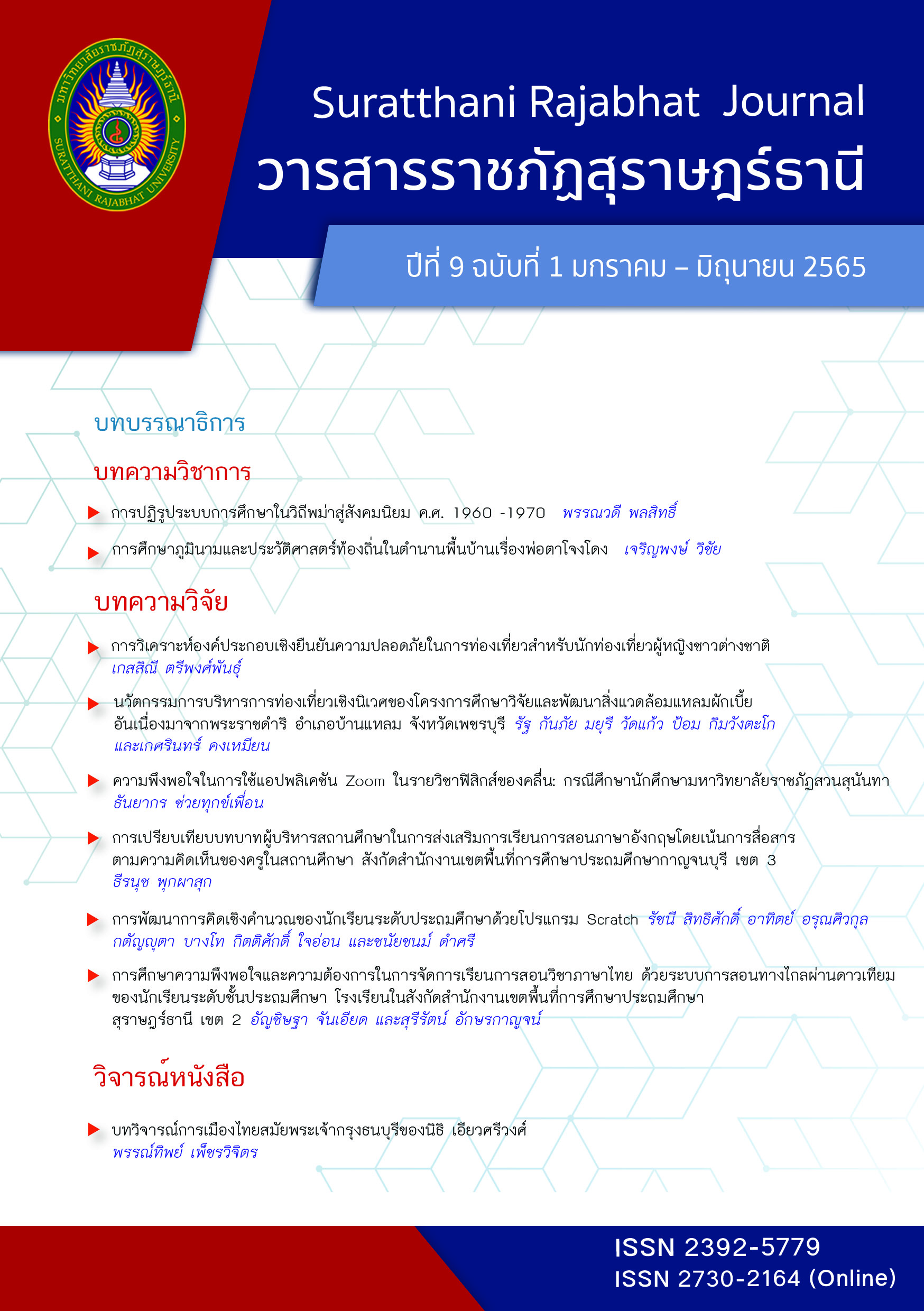Confirmatory Factor analysis of tourism safety for foreign female tourists.
Main Article Content
Abstract
This research aimed to analyse the confirmatory factors of tourism safety for foreign female tourists. The sample size was 384 foreign female tourists whose data were collected through online questionnaires. Purposive sampling, a non-probability sampling technique, was implemented in the survey with the Item Objective Congruence (IOC) of 0.70. The reliability was evaluated with the Cronbach's alpha coefficient of 0.98 by analyzing the confirmatory component data. The results revealed five notable components: 1) environment, 2) war or political unrest, 3) insecurity of tourist attractions and traveling, 4) assessment of damage caused by incidents of insecurity, and 5) insecurity of the place. The second order confirmation element analysis results included the relative chi-square ratio [chi-square (x2)] of 1.83, the Root Mean Square Error of Approximation (RMSEA) of .046, the Comparative Fit Index (CFI) of .97, the Goodness of Fit (GFI) of .91, the Tucker Lewis Index (TLI) of .97 and the Correlation Index Value of .95. This component analysis allowed for quality measurement of tourism safety as reflected by the Composite Reliability (CR) range of .89 - .95, the Average Variance Extracted (AVE) of .67-.74 and the Maximum Shared Variance (MSV) of .52 -.62. The results offer emerging applications for the safety management policy planning of foreign female tourists in Surat Thani Province.
Article Details

This work is licensed under a Creative Commons Attribution-NonCommercial-NoDerivatives 4.0 International License.
References
กระทรวงการท่องเที่ยวและกีฬา. (2561). ทิศทางการตลาดการท่องเที่ยวปี 2562. https://www.mots.go.th/mobile_detail.php?cid=56&nid=10572.
กระทรวงการท่องเที่ยวและกีฬา. (2563). สรุปรายได้และค่าใช้จ่ายจากการนักท่องเที่ยวชาวต่างชาติที่เดินทางเข้าประเทศไทยปี 2562. https://www.mots.go.th/ more_news_new.php?cid=521.
การท่องเที่ยวแห่งประเทศไทย. (2560). การสัมมนาการสร้างเครือข่ายผู้ทรงคุณวุฒิด้านการวิจัยการตลาดท่องเที่ยว ปี 2562. https://www.prthailand.com/news /news-191003-01.shtml.
ณัฐพงศ์ เลิศวุฒิรักษ์. (2561). ปัจจัยหลักที่ส่งผลกระทบต่อพฤติกรรมการท่องเที่ยวสมัยใหม่. https://www.marketingoops.com/exclusive/insiderexclusive/factors-affecting-chinese-tourist-behavior/.
ทวีศักดิ์ แตะกระโทก.(2561). เจ้าหน้าที่ความปลอดภัยในกิจกรรมท่องเที่ยว ก้าวใหม่ที่ไม่ซ้ำรอยเดิม. https://www.posttoday.com/social/think/55 7274.
นพดล นิ่มสุวรรณ และอริศรา บุญรัตน์. (2563). สาเหตุความไม่ปลอดภัยในการท่องเที่ยวอำเภอหาดใหญ่ จังหวัดสงขลา. วารสารการบริการและการท่องเที่ยวไทย, 15(1), 46-57.
นรเศรษฐ์ คำสี และสมยศ วัฒนากมลชัย. (2561). อิทธิพลของการรับรู้เรื่องความปลอดภัยของแหล่งท่องเที่ยวผ่านสื่อสังคมออนไลน์ที่มีต่อการตัดสินใจเดินทางมาท่องเที่ยวจังหวัดเชียงใหม่. การประชุมวิชาการและนำเสนอผลงานวิชาการระดับชาติ ครั้งที่ 2: UTCC Academic Day (น. 1198-1208). กรุงเทพฯ: มหาวิทยาลัยหอการค้าไทย.
นรินทร์สิรี เชียงพันธ์. (2560). ปัจจัยที่มีอิทธิพลต่อพฤติกรรมการท่องเที่ยวของนักท่องเที่ยวเพศหญิงชาวต่างชาติที่เดินทางท่องเที่ยวในกรุงเทพมหานคร. [วิทยานิพนธ์ปริญญามหาบัณฑิต]. สถาบันบัณฑิตพัฒนบริหารศาสตร์.
บุญเลิศ จิตตั้งวัฒนาและภัทรวดี วงศ์ปันทะนัน.(2557). การจัดทำแผนธุรกิจท่องเที่ยว. เฟริ์นข้าหลวง พริ้นติ้งแอนด์พับลิชชิ่ง.นนทบุรี.
บีบีซีนิวส์. (2561). คดีเกาะเต่า 4 ประเด็นน่าสนใจคดีอาชญากรรมนักท่องเที่ยวต่างชาติ. https://www.bbc.com/thai/thailand-45327318.
ปุริมพัฒน์ ธนาพันธ์สิริ. (2559). การจัดการความปลอดภัยในชีวิตและทรัพย์สินให้กับนักท่องเที่ยวของตารวจท่องเที่ยวจังหวัดภูเก็ต. วารสารวิชาการมหาวิทยาลัยราชภัฏภูเก็ต, 12(1), 123-150.
พิมพร ศรีรุ่งเรืองและวารัชต์ มัธยมบุรุษ. (2563). พฤติกรรมนักท่องเที่ยวชาวต่างชาติในการป้องกันตนเองให้มีความปลอดภัยในชีวิตและทรัพย์สินในเมืองพัทยา. วารสารวิชาการวิทยาลัยบริหารศาสตร์, 2(3), 69-89.
ภาวิณี เอี่ยมตระกลู, ภูริเชษฐ์ กฤตยานุกลู และทัตเทพ หนูสุข. (2558). พฤติกรรมและทัศนคติของนักท่องเที่ยวชาวต่างชาติที่ส่งผลต่อความปลอดภัย ทางถนนสำหรับการท่องเที่ยวในประเทศไทย. วารสารการบริการและการท่องเที่ยวไทย, 10(1), 88-105.
มัชฌิมา อุดมศิลป์ และนรินทร์ สังข์รักษา. (2559). การจัดการความปลอดภัยด้านการเดินทางท่องเที่ยวในภูมิภาคตะวันตก สู่ประชาคมอาเซียน: พันธกิจที่ต้องทบทวน?. Veridian E-Journal, 9(3), 260-270.
วารานัย ยุวนะเตมีย์. (2558). การรับรู้ความเสี่ยงของนักท่องเที่ยวชาวต่างชาติที่เดินทางมาท่องเที่ยวในประเทศไทย. [วิทยานิพนธ์ปริญญาโท]. มหาวิทยาลัยธุรกิจบัณฑิตย์.
สำนักงานสถิติแห่งชาติ. (2563). จำนวนนนักท่องเที่ยวต่างชาติที่เข้ามาประเทศไทยจำแนกตามเพศ พ.ศ.2553-2562. http://statbbi.nso.go.th/staticreport/ page/sector/th/17.aspx.
สิริรัตน์ สุวณิชย์เจริญ และปราโมช เชี่ยวชาญ. (2557). การจัดการความปลอดภัย (Managing Safety). [จุลสารสาขาวิชาวิทยาศาสตร์สุขภาพออนไลน์]. กรุงเทพฯ: โรงพิมพ์มหาวิทยาลัยสุโขทัยธรรมมาธิราช.
อธิป นนทกะตระกูล. (2557). แนวทางการจัดการความปลอดภัยของเกสต์เฮ้าส์ในย่านถนนข้าวสารกรุงเทพมหานคร. [วิทยานิพนธ์ปริญญาโท]. สถาบันบัณฑิตพัฒนบริหารศาสตร์.
Bianchi, C. (2016). Solo holiday travelers: Motivators and drivers of satisfaction and dissatisfaction. International Journal of Tourism Research, 18(2), 197-208.
Booking. (2014). Holiday with me, myself and I lead to a self esteem boost for British women. https://news.booking.com/holidays-with-me-myself-and-i-leads-to-a-self-esteem-boost-for-british-women/.
Byrne, B. M. (2001). Structural equation modelling with AMOS: Basic concepts, applications, and programming. Mahwah, NJ: Lawrence Erlbaum Associates, Inc.
Cochran, W.G. (1977) . Sampling Techniques. (3rd ed.) New York : John Wiley and Sons Inc.
Crawford, D. W., & Godbey, G. (1987). Reconceptualizing barriers to family leisure. Leisure Sciences, 9(2), 119-127.
Diamantopoulos, A. & Siguaw, J. A., (2000). Introduction to LISREL: A guide for the uninitiated. London: SAGE Publications, Inc,.
Gilbert, D., & Hudson, S. (2000). Tourism demand constraints: A skiing participation. Annals of Tourism Research, 27(4), 906-925.
Gomes, J., & Montenegro, M. (2016). Profile of female tourists visiting porto and north of Portugal. Worldwide Hospitality and Tourism Themes, https://search.proquest.com/docview/1846292872?accountid=3212 3.8(6), 677-690.
Hair, J.F., Black, W.C., Bain, B.J., Anderson, R.E., and Tatham, R.L. (2006). Multivariate data analysis (6th ed.). Upper Saddle River. NJ: Pearson Education International.
Hu LT & Bentler PM. (1999). Cut-off criteria for fit indexes in covariance structure analysis: Conventional criteria versus new alternatives. Structural Equation Modelling. 6:1–55.
Kaplan, D., (2000). Structural Equation Modelling. Sage Publications, Thousand Oaks, California.
Kasum, J., Zanic J., & Kolic V. (2018). Safety Issues, Security and Risk Management in Nautical Tourism. Transections on Maritime Science Split, Croatia, 7(2), pp. 184–188. doi: 10.7225/toms.v07.n02.008.
Kline, R. B. (2010). Principles and practice of structural equation modelling (3rd ed.) New York: Guildford Press.
Kour, P., & Gupta, S. (2019). Analysis of travel risk perception and travel intentions among solo female travelers towards Kashmir as a destination. Clear International Journal of Research in Commerce & Management, 10(3).
Lutz, J. & Ryan, C. (1993). Hotels and the businesswoman: an analysis of business-women’s perceptions of hotel services. Tourism Management, 14(5), 349-356.
Mansfeld, Y.& Pizam, A. (2016). Tourism, security, and safety: from theory to practice. Routledge.
McCleary, K.W., Weaver, P.A.& Lan, L. (1994). Gender-based differences in business travelers’ lodging preferences. The Cornell Hotel and Restaurant Administration Quarterly, 35(2), 51-58.
Nakphin, S. & Buafai, T. (2018). The Causal Effects of Island Tourism Safety Perception toward Island Destination Loyalty of International Tourists: A Case of Samui Island, Thailand. Journal of International and Thai Tourism, 14(2), 26-47.
Nunnally, J.C. & Bernstein, I.R. (1994). Psychometric theory, Ed.ke-3, McGraw-Hill, New York.
Pallant, J. (2001). SPSS survival manual - a step by step guide to data analysis using SPSS for windows (version10). Buckingham Open University Press.
Pemberton, J. (2014). She’s looking for adventure, she's going alone, and she'll tell you all about it: introducing the solo female traveller. www.adventuretravelnews.com/shes-looking-for-adventure-shesgoing alone-and-shell-tell-you-all-about-it-introducing-the-solofemale-traveller, Adventure Travel News.
Rostamian, A., Kalantari, M. R., Rostamian, R., & Nor, S. A. M. (2012). Tourism management theories. The Journal of American Science, 8(8), 314-318.
Steiger JH & Lind JM. (1980). Statistically based tests for the number of common factors; Paper presented at the annual meeting of the Psychometric Society; Iowa City, IA.
World Economic Forum. (2017). The Travel and Tourism Competitiveness Report 2017. http://www3.weforum.org/docs/ WEF_TTCR_ 2017_ web.


